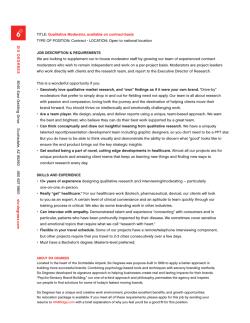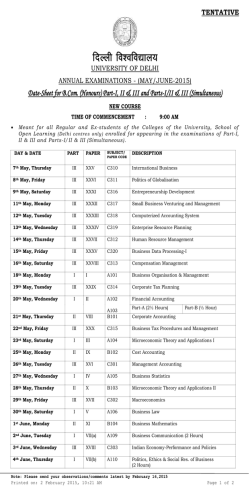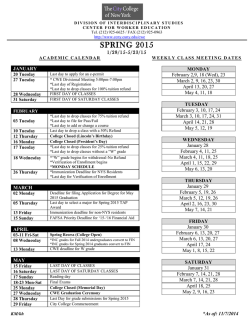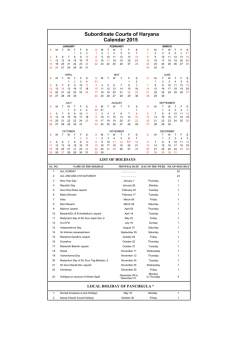
Policy Evaluation for Managers (API – 206)
Last Updated: January 30, 2015 Fundamentals of Program and Policy Evaluation (API – 206) Spring 2015 Course Syllabus Faculty: Janina Matuszeski Email: [email protected] Phone: 617-495-3561 Office: L208 Faculty Assistant: Sarah McLain Email: [email protected] Office: 124 Mt. Auburn - Suite 200N-217A Teaching Fellow: Lisa Xu Email: [email protected] Office Hours: Wednesdays 3-5 pm Course Assistant: Rae Binder Email: [email protected] Office Hours: Tuesdays 5:30-6:30 pm Office: Taubman 301 Office: Taubman Study Carrel 1 Weekly Schedule Tuesday Thursday Friday Lecture (Starr) 8:40am – 10am 8:40am – 10am Section (L-140) 8:40am – 10am Office Hours Prof. Matuszeski* TF and CAs 3-4pm See Above 1-3pm * Or by appointment REQUIRED FRIDAY CLASSES NOTE: This course includes mandatory attendance from 8:40-10am on the following two Fridays: February 13 (focus group discussion exercise) and April 24 (Exam). In addition, attendance is encouraged for Friday, May 1 (optional class on monitoring). DO NOT take this course if you cannot commit to attend on Feb 13 and April 24 from 8:40-10am. Overview This course provides the basic evaluation tools and understanding necessary for students to become critical consumers and effective users of evaluations, thereby building higher quality programs and policies. Topics covered include reasons for and uses of evaluations, evaluation design, comparisons of qualitative, quantitative and mixed method approaches, practical challenges in data collection and analysis, estimation of program impacts, selection and management of researchers and research agencies, dissemination of findings, and integration of findings into policy and organizational strategy. Students will analyze the evaluations of a variety of programs and policy instruments through exercises and case studies. The course is divided into four sections • Introduction to evaluation – 2 days 1 Last Updated: January 30, 2015 • • • Qualitative approaches and methods – 6 days Quantitative approaches and methods – 12 days Evaluation design, management, dissemination and integration into strategy – 7 days Types of questions we will be interested in exploring: • What types of studies are included under the umbrella “evaluation of programs”? • How do we estimate the impact (causal effect) of a program? What are the advantages and disadvantages of different quantitative and qualitative evaluation methods? How do we assess the validity of an impact evaluation? • How do we determine what sample size is needed to evaluate the impact of a program? • When and why is it beneficial to mix quantitative and qualitative methods? • Under what circumstances are evaluations likely to affect policy decisions? How can one help evaluations feed into organizational strategy? Target audience People interested in becoming critical consumers of program evaluations. You may be interested in taking this course if you plan to work for, or be involved with, an agency that implements social programs, either domestically or internationally, and is interested in evaluating how well its programs are performing. You may also be interested in the course if you want to learn about how research methods (both quantitative and qualitative) are used in the real world to help inform social policy. Prerequisite Familiarity with the basic concepts of statistical inference at the level of API-205, API-201 or similar. Books Required textbooks (available at the COOP): Peter H. Rossi, Mark W. Lipsey, and Howard E. Freeman. 2004. Evaluation: A Systematic Approach. 7th edition. (Thousand Oaks CA. Sage.) [An excellent all-around text, especially for framing evaluation] Robert Yin. 2011. Qualitative Research from Start to Finish. Guilford Press. [The course’s key resource for qualitative approaches and methods. Very practical and with good examples.] Recommended books (available at the COOP): There will be some readings from these books and they are generally useful books to have. These may be purchased at the COOP. However, you are not required to purchase these books. Any readings from these will be available either through OCM or HKS library reserves. Richard A. Berk and Peter H. Rossi. 1999. Thinking about Program Evaluation. Sage. [A short book which does an excellent job of framing evaluation, why we do it and what the key questions are. We will read all four short chapters of this book over the course of the class. There are 2 HKS reserves copies. But you may want to buy your own copy or plan to share a copy with a fellow student(s). This reading material will NOT be on OCM.] Michael Bamberger, Jim Rugh and Linda Mabry. 2012. Real World Evaluation: Working under Budget, Time, Data and Political Constraints. 2nd edition. Sage. [This book focuses on the nitty gritty of real-world evaluation, with many practical suggestions. The authors sometimes give up too easily on more rigorous methods, but this is a great practical resource for your post-HKS library.] 2 Last Updated: January 30, 2015 Rachel Glennerster and Kudzai Takavarasha. 2013. Running Randomized Evaluations: A Practical Guide. Princeton University Press. [A fabulous resource on the theory and practice of running randomized evaluations in the field, by one of the directors of JPAL.] Other books: These are other interesting texts, often on specialty topics. Required readings from these will be rare and will be available either through OCM or HKS library reserves. You are welcome to glance through my copies anytime. Peter Kennedy. A Guide to Econometrics. Any edition (eg. 2008 6th edition). [A great resource for the basic econometrics behind the quantitative methods and analysis we will study, especially for students with little or no econometrics.] John Creswell. 2013. Qualitative Inquiry and Research Design: Choosing Among Five Approaches. 3rd edition. Sage. [An excellent resource on qualitative approaches. Very similar in content to the required textbook by Yin. The Yin text has a few more practical suggestions. But this book does an excellent job describing the social science frameworks underlying qualitative research.] Michael Quinn Patton. 2003. Qualitative Research & Evaluation Methods. 3rd edition. Sage. [This is the ultimate qualitative methods reference by the granddaddy of qualitative research. More advanced than this course requires. But a fantastic resource for those interested in qualitative methods.] Joseph Wholey, Harry Hatry, and Katheryn Newcomer. 2010. Handbook of Practical Program Evaluation. 3rd edition Jossey-Bass [Another overall evaluation textbook. Only some chapters are good.] Handouts Handouts will be distributed throughout the course. The main objective of the handouts is to facilitate the process of taking notes so that students can fully engage in class. They are not meant to substitute for class attendance or for studying the assigned reading material. Handouts will contain blank spaces for students to fill in during class, usually in response to questions. Grading: The class grade will be based on the following criteria: 10% - Class participation and engagement 30% - Five short assignments (#1, 3, 4, 6 and 7) 35% - Final exercise – Assignments 2, 5, and 8, and final paper 25% - Exam on Quantitative Material Class participation and engagement I believe that student participation can substantially enrich the learning experience for both the students and the instructor. In this spirit, class participation is strongly encouraged. Effective class participation requires that you read the required readings before coming to class. I will strive to lead stimulating discussions and will ask questions to highlight concepts and assess class comprehension. You are encouraged to ask questions and to share with the class any relevant insights you may have from your work experience or from previous exposure to these topics. I only ask that the questions and comments be related to the topic at hand and be as concise as possible. 3 Last Updated: January 30, 2015 Assignments There will be five short assignments during the course (#1, 3, 4, 6 and 7) in addition to intermediate assignments associated with the final exercise (#2, 5 and 8). Assignments not received before the deadline will be considered late and receive no credit, with exceptions made for medical or family emergencies only. Under the Kennedy School Academic Code, the assignments for this course are “Type II” assignments. Students may work on the assignment with one to three other students, but each student should write up and hand in his or her own solutions to the problems. You must indicate on the top right corner of the first page the names of any students you worked with. ASSIGNMENTS: Fraction of total course grade in parenthesis. Assignments tied to the final exercise are marked with (*): Assignment 1 (5%): Participation in the construction of a course-wide “evaluation toolkit,” which will be a resource for you in the future. During the first week of class, each student will sign up for a topic (1 or 2 classes-worth of material) during the coming semester. Some topics may have two students. For your assigned topic, you will add between ½ and 2 pages to the toolkit, including key concepts, references, and links to important tools related to that topic. A course assistant will give you one round of feedback before material is added to the toolkit. You may use last year’s toolkit (provided) as a reference but the toolkit should reflect insights from this year’s course. *Assignment 2 (0%): Final exercise – Policy/program area Assignment 3 (4%): Brief analysis of Focus Group Discussion exercise Assignment 4 (7%): Qualitative Interview exercise and analysis *Assignment 5 (10%): Final exercise – Policy/program theory and logic and evaluation questions Assignments 6 and 7 (7% each): Quantitative analysis exercises using real-world data. These exercises will use Excel and not Stata *Assignment 8 (5%): Final exercise – Outline of evaluation design *Final paper (20%): Final exercise – 10-page paper with program theory and evaluation design Final exercise The final exercise will pull together many of the tools learned in class. In this exercise, you will design a complete evaluation system for a program or public policy issue which you care about. Your analysis may include: the role of the evaluation within the organization or network, a dissemination plan, an analysis of the program theory and logic, the major evaluation questions, appropriate methods, a sample Terms of Reference (or Request for Proposals), and an approximate budget. You will be asked to do this exercise in steps and submit your interim work throughout the semester. (Assignments 2, 5 and 8: policy/program area; policy/program theory and logic, and evaluation questions; outline of evaluation design; final 10-page paper). With instructor permission, students may choose an alternate final exercise in which they evaluate existing evidence for a policy or program of interest. Students may choose to work independently or in groups of two students for either topic. 4 Last Updated: January 30, 2015 Exam on Quantitative Material The exam covers the quantitative material from the middle of the semester (Feb 19 to Apr 9). It occurs quite late in the semester, after this material has been covered. The exam counts for 25% of your final grade. Assignments and Final Exercise Due Dates: Date Various dates Tuesday, February 10 Tuesday, February 17 Tuesday, February 24 Thursday, March 5 Thursday, March 12 Thursday, April 9 Thursday, April 16 Friday, April 24 Monday, May 11 Assignment Assignment 1 - Toolkit Assignment 2 - Final exercise – Policy/program area Assignment 3 - Brief analysis of Focus Group Discussion exercise Assignment 4 - Qualitative Interview exercise and analysis Assignment 5 - Final exercise - Policy/program theory & logic; evaluation questions Assignment 6 - Quantitative analysis exercise Assignment 7 - Quantitative analysis exercise Assignment 8 - Final exercise – Outline of evaluation design Exam On Quantitative Material Final exercise - 10-page paper with program theory and evaluation design Course page software pilot: This course has been selected to participate in a pilot of new course page software, Canvas. The software will allow for accurate tracking of class participation and attendance, submission of assignments, and several class discussions. A class discussion on the course page will be an ongoing place for students to post what is and what is not working about the new system. Your participation and feedback about Canvas as a tool will help with the HKS-wide roll-out of the software in Fall 2015. And you will all already be experts! 5 Last Updated: January 30, 2015 Detailed Schedule and Readings [R] indicates a required reading. ALL STUDENTS are expected to complete this reading PRIOR to class. [A] indicates an optional, advanced or supplemental reading. Students are not required to complete this reading prior to class but may find it to be a useful additional resource. “RLF” is Rossi, Lipsey, and Freeman (2004). Other textbook references are listed under “Books” above. INTRODUCTION TO EVALUATION Thursday, January 29: Evaluation overview (evaluation types, goals and steps; intro to dissemination and strategy) [R] “Why not measure how well government works?” Washington Post. April 15, 2013. [R] RLF, Chapters 1-2 [A] Berk and Rossi, Chapters 1-2 [An in-depth discussion of “validity” of various forms.] [A] Wholey, Hatry and Newcomer, Chapter 23 [An entertaining chapter on pitfalls in evaluations, especially if you have some experience with evaluations.] Tuesday, February 3: Program theory [R] RLF, Chapters 3 and 5 [A] Berk and Rossi, Chapter 3 [Another way to think about evaluation questions to be answered. Very practical.] QUALITATIVE APPROACHES AND METHODS Monday, February 2: Qualitative frameworks, planning and sampling [R] Yin, Chapter 1, Chapter 2 (pg 26-43 only), Chapter 4 (pg 82-92) [R] Creswell, Table 4.1 (pg 104-106) [A] Creswell, Chapter 3 [More on designing a qualitative study. Excellent section on ethics.] [A] Creswell, Chapters 2 and 4 [More on the philosophy behind qualitative research in Chapter 2 and on five different qualitative frameworks in Chapter 4] 6 Last Updated: January 30, 2015 Thursday, February 5: Qualitative interview methods [R] Yin, Chapters 6-7 Tuesday, February 10: Focus group discussion methods I [R] Wholey, Hatry, and Newcomer. Chapter 17 (pg 378-396 only) Thursday, February 12: Additional qualitative methods; Qualitative analysis [R] Yin, Chapter 3 (pg 61-65 only), Chapter 5 [R] Yin, Chapters 8-9 Mandatory Class Friday, February 13: Focus group discussion methods II No readings. Tuesday, February 17: Guest lecture on policy advocacy evaluation or data ethics [R] TBD - Possibly a short handout from guest speaker QUANTITATIVE APROACHES AND METHODS Thursday, February 19 and Tuesday, February 24: Evaluation frameworks and overview [R] Berk and Rossi, Chapter 4 (pg. 66-82 only) [R] Glennerster and Takavarasha, pg 392-398 [R] Ravallion, Martin. 2001. “The Mystery of the Vanishing Benefits: An Introduction to Impact Evaluation.” The World Bank Economic Review. 15(1): 115-140. [R] Come to class with 1-2 examples of a popular press article in which correlation and causation are confused. Prepare a 3 sentence description of the article to share with a neighbor (oral or written is fine). 7 Last Updated: January 30, 2015 Thursday, February 26: Reading regressions; Comparison groups [R] Wholey, Hatry and Newcomer, Chapter 6 (pg 125-135 only) [R] Glennerster and Takavarasha, Chapter 2 (pg 24-35 only) Tuesday, March 3: Difference-in-difference [A] Glennerster and Takavarasha, Chapter 2 (pg 38-39 only) Thursday, March 5: Social experiments (RCTs) – Part I [R] Glennerster and Takavarasha, Chapter 2 (pg 44-65 only) [R] "Random Harvest: Once treated with scorn, randomized control trials are coming of age." The Economist. 14 December 2013. [A] RLF, Chapter 8, Chapter 9 (pg 266-274 only) [This reading gives another perspective on RCTs] [A] Library Reserve: Wholey, Hatry and Newcomer, Chapter 7 [This reading gives another perspective on RCTs] Tuesday, March 10: Social experiments (RCTs) – Part II [R] Case 2005.0: "Hormone Replacement Therapy" Thursday, March 12: Matching and interrupted time series [R] Glennerster and Takavarasha, Chapter 2 (pg 35-38 only) [R] Wholey, Hatry and Newcomer, Chapter 6 (pg 135-139 only) [A] RLF, Chapter 9 (pg 274-279 and pg 289-297 only) [Low priority reading. Read this only if these techniques interest you and you want a more complete perspective.] [A] Berk and Rossi, Chapter 4 (pg 83-103 only) [Low priority reading. Read this only if these techniques interest you and you want a more complete perspective.] [R] Dehejia, Rajeev H., and Sadek Wahba. 1999. “Causal Effects in Nonexperimental Studies: Reevaluating the Evaluation of Training Programs.” Journal of the American Statistical Association. 94(448): 1053-1062. [Read the “easy” parts of this paper and don’t worry about the complicated parts.] 8 Last Updated: January 30, 2015 [R] Bloom, Howard S. 2003. “Using ‘Short’ Interrupted Time-Series Analysis to Measure the Impacts of Whole-School Reforms.” Evaluation Review. 27(1): 3-49. [Read the “easy” parts of this paper and don’t worry about the complicated parts.] Tuesday, March 17 and Thursday, March 19: Spring Break (no classes) Tuesday, March 24: Instrumental Variables [R] Glennerster and Takavarasha, Chapter 2 (pg 41-44 only) [R] Levitt, Steven D. 1997. “Using Electoral Cycles in Police Hiring to Estimate the Effect of Police on Crime.” American Economic Review. 87(3): 270-290. [Read the “easy” parts of this paper and don’t worry about the complicated parts.] Thursday, March 26: NO CLASS Tuesday, March 31: Regression discontinuity designs; Data visualization [R] Glennerster and Takavarasha, Chapter 2 (pg 39-41 only) [R] Wholey, Hatry and Newcomer, Chapter 6 (pg 139-142 only) [R] Look on the web or in print materials you have for 1-2 examples of a visual display of data. See below for suggestions for sources or find your own material. Critique these displays. Write down 1-2 things you liked and 1-2 problems. Think about the audience in each case. Suggested sources: http://www.washingtonpost.com/blogs/worldviews/wp/2013/08/12/40-mapsthat-explain-the-world/?lines; http://www.washingtonpost.com/blogs/worldviews/wp/2014/01/13/40-more-maps-that-explain-theworld/; http://visualizing.org/; http://flowingdata.com/ many other websites. [R] Kazianga, Harounan, Dan Levy, Leigh L. Linden, and Matt Sloan. 2013. “The Effects of ‘Girl-Friendly’ Schools: Evidence from the BRIGHT School Construction Program in Burkina Faso.” American Economic Journal: Applied Economics. 5(3): 41-62. [Read the “easy” parts of this paper and don’t worry about the complicated parts. This reading and the next one document the same evaluation. This is the full academic paper. The report by the consultancy Mathematica is longer but easier to follow. Read and compare the styles.] [A] Kazianga, Harounan, Dan Levy, Leigh L. Linden, and Matt Sloan. “Impact Evaluation of Burkina Faso's BRIGHT Program Final Report.” Mathematica Policy Research Institute. 12 June 2009. Thursday, April 2: Statistical power [R] Glennerster and Takavarasha, Chapter 6, (Module 6.3, pg 267-271, is optional. The section on statistical software tools, pg 284-289, is optional as well.) 9 Last Updated: January 30, 2015 [R] Lowrey, Annie. “Medicaid Access Increases Use of Care, Study Finds.” New York Times. 1 May 2013. [R] Klein, Ezra. “Here’s what the Oregon Medicaid study really said.” Washington Post. 2 May 2013 Tuesday, April 7: Sampling design [R] Wholey, Hatry and Newcomer, Chapter 12 Thursday, April 9: Survey instruments and types of data collection No readings (see readings for April 7). EVALUATION DESIGN, MANAGEMENT, DISSEMINATION & INTEGRATION Tuesday, April 14: Process evaluation [R] RLF, Chapter 6 Thursday, April 16: Mixed methods [R] Bamberger, Rugh, and Mabry, Chapter 14 [R] Case 2007.0: "The Geography of Poverty: Exploring the Role of Neighborhoods in the Lives of Urban, Adolescent Poor" [A] Ellsberg, Mary and Lori Helse. In Researching Violence Against Women: A Practical Guide for Researchers and Activists. [This is very long, 259 pages. But it is a very useful document on conducting research on the subject of violence against women in an ethical manner, including many practical suggestions. I would not expect you to read even close to all of this but feel free to pick a section or two to read. It covers both quantitative and qualitative approaches.] Tuesday, April 21: First half of class: Sustainability and long-term impact Second half of class: Possibly guest lecture by Iqbal Dhaliwal, Deputy Director, Director of Policy and Scientific Director (South Asia) of J-PAL. [R] Iqbal Dhaliwal & Caitlin Tulloch (2012). “From research to policy: using evidence from impact evaluations to inform development policy.” Journal of Development Effectiveness. 4:4. 515-536. 10 Last Updated: January 30, 2015 Thursday, April 23: Dissemination [R] Pick TWO of the following three sources and read the article(s), watch the video(s) and/or poke through the website. In each case, do a critique of their dissemination: Write down 1-2 things you liked and 1-2 problems. Think about the audience in each case. Option A: Read NY Times article: "Guesses and Hype Give Way to Data in Study of Education" and poke around this website (http://ies.ed.gov/ncee/wwc/). Option B: Watch these two videos: (http://www.youtube.com/watch?annotation_id=annotation_2213735445&feature=iv&src_vid=_4 bJtCWnL2I&v=6nG63ISt_Ek and http://www.youtube.com/watch?v=_4bJtCWnL2I) Option C: Look through the material on these webpages and the documents linked to these webpages: This is the main page (http://policy-practice.oxfam.org.uk/our-work/methods-approaches/projecteffectiveness-reviews?cid=rdt_effectiveness) and here is an example webpage for one program (http://policy-practice.oxfam.org.uk/publications/effectiveness-review-livestockcommercialisation-for-pastoralist-communities-in-262466). [A] Sutherland, William J., David Spiegelhalter, and Mark Burgman. “Policy: Twenty tips for interpreting scientific claims.” Nature. 20 November 2013. [A] Tyler, Chris. “Top 20 things scientists need to know about policy-making.” The Guardian. 2 December 2013. [A] Wholey, Hatry and Newcomer, Chapter 25 Friday, April 24: EXAM ON QUANTITATIVE MATERIAL Tuesday, April 28: Integration of evaluation into organizational strategy; Evaluation management [R] Pritchett, Lant. 2002. “It Pays to be Ignorant: A Simple Political Economy of Rigorous Program Evaluation.” The Journal of Policy Reform. 251-269. [R] Wholey, Hatry and Newcomer, Chapter 26 [A] Niehaus, Paul. "A Theory of Good Intentions." [A] Liebman, Jeffrey B. "Building on Recent Advances in Evidence-Based Policymaking." [A] Heyward, April. "OMB: Use of Evidence and Evaluation in FY 2014 Budget" (Read also the actual 5-page OMB memo which has a link at the end of this Heyward's article). 11 Last Updated: January 30, 2015 Thursday, April 30: Case study: Designing Impact Evaluations: Assessing Jamaica’s PATH Program [R] Case study CR14-09-1903.0: “Designing Impact Evaluations: Assessing Jamaica’s PATH Program” Friday, May 1: (Optional lecture) Monitoring and indicator approaches [R] Clarke, Wendy Mitman. 2003. "The Sneaker Index." Window on the Chesapeake. [R] "Bernie Fowler measures a sneaker index of 34 inches at annual wade-in." Chesapeake Bay News. 12 June 2013. 12
© Copyright 2026





